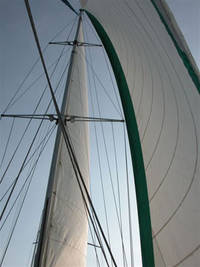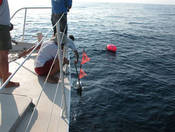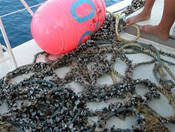May 18, 2005
Sighting in the high seas. Wednesday, May 18th, 2005
The crossing of the Atlantic continues without delay. The sea remains practically calmed, with some moments of wind blowing at 10 to 15 knots which have allowed us today, for the first time, to raise all sails and navigate without the help from the two motors during some time, pushing the Ranger ahead at 6 or 7 knots. The problem was that in order to take advantage of this wind, we had to set course further north than it was convenient for us to reach Azores. At last we have decided to compromise; combining all sails, one of the motors and a more acceptable course to our needs.

Nevertheless, the excellent visibility of the sea allowed us to see, in detail, the scarce surface marine fauna at a great distance. The density of Portuguese man-of-war (Physalya physalis)- abundant the previous days- has been decreasing; however, we have sighted up to half a dozen marine turtles: loggerhead sea turtles (Caretta caretta) of large size, catching the sun on the surface. A minke whale (Balaenoptera acutorostrata) swam across the prow of the ship this morning, livening up Alicia’s guard shift.
In this oceanic remoteness, it is impressive to observe the surface level flight of some isolated individuals belonging to different marine bird species. It is hard to imagine the daily routine of these animals, at hundreds of miles from any island or continent, flying in solitary over the waves. The onboard ornithologists: the cook, Jose Indi Peñalver and the captain Nuño Ramos help us identify them: they were a great skua (Catharacta skua), and a long tailed jaeger (Stercorarius longicaudus). We have also sighted a petrel, a small pelagic sea bird, but we were not able to identify the species. And, in Indi’s words: “If I am not 100% sure, I rather not confirm identification”.
But observing marine life is becoming the exception, not the rule. Most of the time, the sea and the sky appear empty and solitary, which becomes more overwhelming when the ocean is calmed, the firmament blue and clear, and visibility, is extraordinary.


Once in a while find floating objects. Hours after we left Bermudas last Sunday, we passed by a piece of synthetic foam the size of a refrigerator. At a distance, it was impossible to distinguish if it was a raft, or some small container fallen from some ship, that may present some danger for navigation. We have also come across several lost parts from ships. Alicia distinguished an inflatable mat, in perfect shape. Yesterday in the afternoon we saw two fishing buoys abandoned, complete with their identifying flags. We decided to come close and examine it in case it may be floaters from some sort of fishing line that could possibly have thousands of hooks still attached or a synthetic string that can potentially go on causing harm to marine life. Available information on this subject are filled with distressing estimates of the amount of nets and other fishing gear lost at sea, which are made of synthetic and resistant materials that continue killing fish, crustaceans, marine mammals and turtles as “phantom killings” for years.

For this reason, Carlos, Jose Carlos and Guayo made efforts to haul buoys onboard, with the help of a gaff, while Nuño carefully maneuvered the Ranger to keep the propellers from getting entangled with the fishing gear. However, the floaters were not connected to a synthetic line but to a thick rope that sank into the water, we did not know how deeply. We began to pull it up, only to discover it was about 10 meters long. When we hoisted it onto the deck we brought along an entire ecosystem. The submerged part of the buoys, as well as the rope were covered with common goose barnacle (Lepas anatífera), but there were algae as well and hundreds of tiny crab, similar to those we found a couple of weeks ago in the sargazo sea, before we arrived in Bermudas.
After we took corresponding photographs, we decided to keep one of the floaters onboard (one was in good shape) and throw the rest back in the sea. It did not represent any danger for navigation and yet, it kept thousands of tiny organisms alive, not counting the fish that sought refuge under this small ecosystem and fled horrified when their protection was pulled away.
This afternoon we had a hairstyling session. Mar has brought her “frightening shaving machine” and has left Jose Carlos looking like a pool ball.

